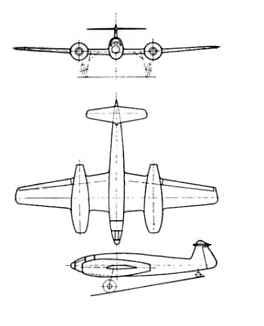In regards to the 1932 patent, as posted previously by Hesham, here's a direct translation. (Apologies to any french speakers!)
'Improvements to air navigation equipment.
Mr Marcel Riffard
Deposited on March 8, 1932.
The subject of the invention is improvements to air navigation devices, which improvements consist mainly of establishing the said navigation devices in question, at the same time as constituting their fuselage by a portion of wing whose cross section preferably a symmetrical biconvex profile, whose lift increases with the angle of attack for commonly used values;
To have the wing, having a profile, preferably symmetrical biconvex, substantially along the plane of symmetry of the fuselage and in such a way that it makes with the fuselage an angle such that the latter moves, in flight under the angle for which its lift and cloud, therefore its minimum drag;
To fix the wings (longitudinal stabilization members) constituted by a single spar and a sheet coating of light alloys with high resistance, on the fuselage in three points being with play so as to allow the adjustment of these wings compared to the fuselage;
To make the landing gear, of the independent wheel type, fully liftable, and retractable fully in the fuselage;
To ensure the cooling of the engine by air circulation on either side of the propeller in the leading edge in the region of highest dynamic pressure and of air outlet orifices on each of the faces of the fuselage in places subjected to equal depressions of the appropriate deflectors giving an outlet direction to the outgoing air currents substantially parallel to the direction of the outside air circulating on the upper surface and the lower surface of the fuselage;
To have the gas exhaust pipes of gas from the engine in the engine's cooling air exit holes, so as to take advantage of the depression.'
Basically it looks like the patent is not only for an aircraft with a retractable undercarriage, but that it also utilises some kind of pivoting wing, perhaps in the manner of the F-8 Crusader. Instead of the wing pivoting on the top of the fuselage, it pivots on the side, dependant on the need at the time. Also from the description of hot air gases etc, I may be guessing here, but that sounds like some kind of blown air system a la YC-14 and YC-15 perhaps.













![Les_Ailes___journal_hebdomadaire_[...]_bpt6k9795496t_7.jpeg](/data/attachments/147/147188-77587425df713eccbe5b1f8d891537b3.jpg)
![Les_Ailes___journal_hebdomadaire_[...]_bpt6k9795496t_8.jpg](/data/attachments/147/147189-8b5ff72a96413beb3b82c47a5985208e.jpg)





![Pégase___revue_de_l'association_[...]Association_des_bpt6k5326446h_22.jpeg](/data/attachments/181/181566-de48c2fc5cd50d62c52f0379b97c6b3e.jpg)












